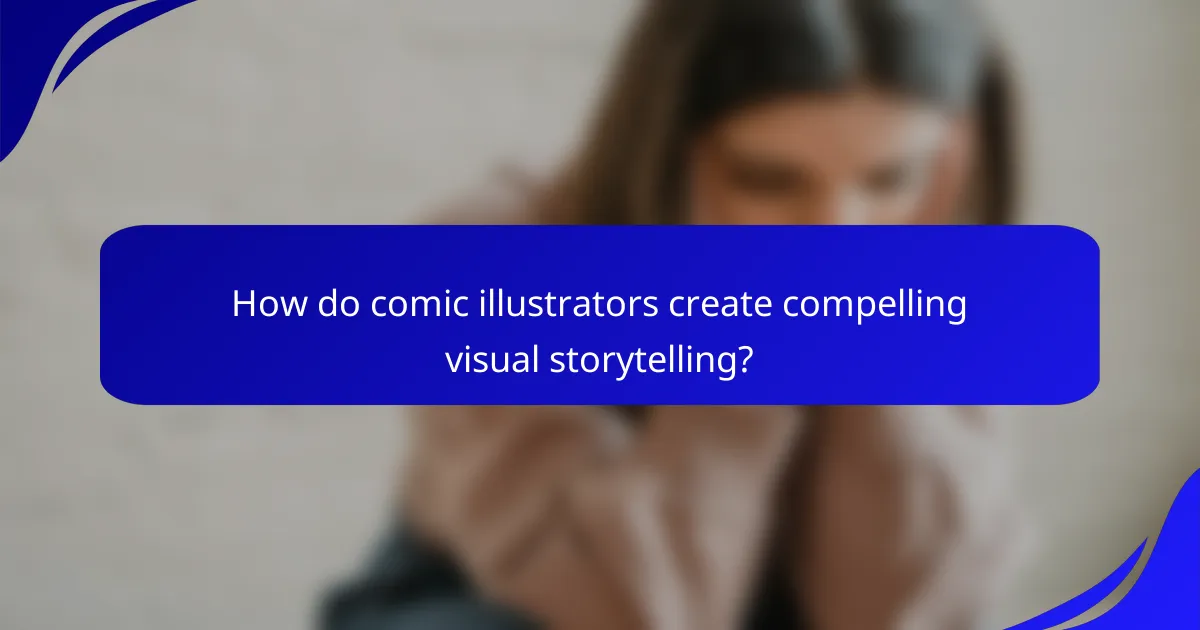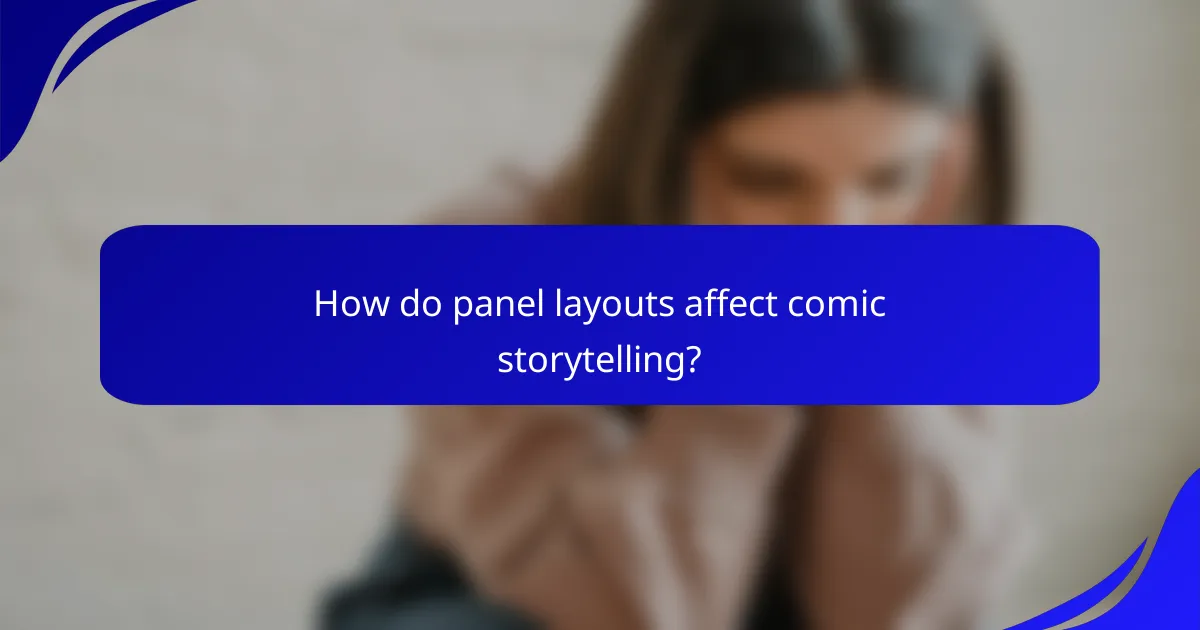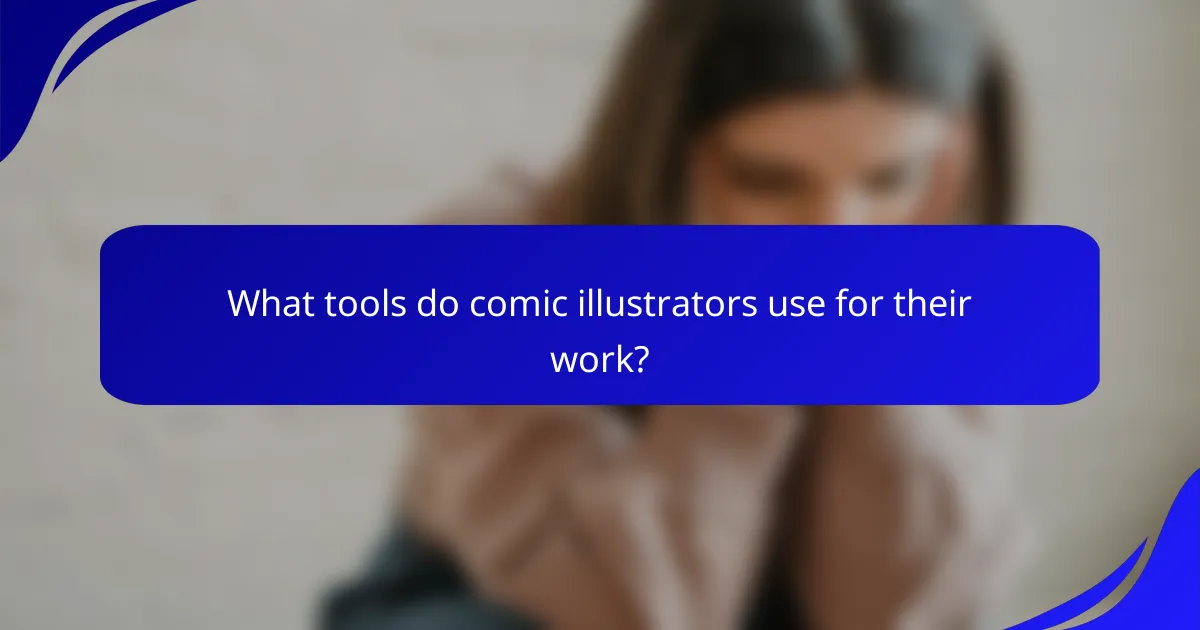Comic illustrators master the art of visual storytelling by skillfully blending narrative techniques with artistic elements. Through thoughtful character design, vibrant color palettes, and strategic panel layouts, they create engaging narratives that resonate with readers and enhance the overall experience.

How do comic illustrators create compelling visual storytelling?
Comic illustrators create compelling visual storytelling by combining art and narrative techniques to engage readers. They utilize elements like color, character design, and panel layout to convey emotions and advance the plot effectively.
Use of color and composition
Color plays a crucial role in visual storytelling, as it can evoke specific emotions and set the tone for scenes. For instance, warm colors like red and orange can create a sense of urgency or passion, while cool colors like blue and green often evoke calmness or sadness.
Composition refers to how elements are arranged within a panel. A balanced composition draws the reader’s eye and helps convey the intended message. Consider using the rule of thirds to create dynamic layouts, where key elements are positioned along imaginary lines that divide the panel into thirds.
Character emotions and expressions
Character emotions and expressions are vital for connecting with the audience. Illustrators should focus on facial features, body language, and gestures to communicate feelings effectively. For example, raised eyebrows and wide eyes can indicate surprise, while slumped shoulders may suggest defeat.
Utilizing close-ups can enhance emotional impact by allowing readers to see subtle changes in expression. This technique can be particularly effective during pivotal moments in the story, drawing attention to the characters’ internal struggles.
Sequential art techniques
Sequential art techniques involve arranging images in a specific order to tell a story over time. This can include varying panel sizes and shapes to create pacing and rhythm, allowing readers to experience the narrative flow. Larger panels can emphasize significant moments, while smaller ones can quicken the pace.
Transitions between panels are essential for maintaining coherence. Techniques such as action-to-action or subject-to-subject transitions help guide the reader smoothly through the story. Understanding these techniques can significantly enhance the overall storytelling experience in comics.

What are the key elements of character design in comics?
Key elements of character design in comics include silhouette and shape, color palette and clothing, and backstory and personality traits. These components work together to create memorable and relatable characters that enhance visual storytelling.
Silhouette and shape
The silhouette of a character is crucial as it provides immediate visual recognition. A strong silhouette can convey a character’s role, personality, and even their emotional state. For example, a tall, angular figure might suggest a villain, while a rounder, softer shape could indicate a friendly character.
When designing silhouettes, consider the overall shape and how it interacts with the character’s movements. Experiment with variations to find the most distinctive outline that stands out against backgrounds and other characters.
Color palette and clothing
The color palette and clothing of a character play a significant role in conveying their personality and mood. Bright colors can suggest energy and optimism, while darker shades may imply mystery or danger. Selecting a cohesive color scheme helps in establishing a character’s identity and emotional tone.
Clothing choices should reflect the character’s background and role within the story. For instance, a superhero might wear a tight-fitting costume with bold colors, while a detective may opt for more subdued, practical attire. Always ensure that the clothing complements the character’s silhouette.
Backstory and personality traits
A character’s backstory and personality traits are essential for depth and relatability. Understanding a character’s history can inform their design choices, such as scars or unique accessories that hint at past experiences. This context enriches the visual storytelling by adding layers to the character’s appearance.
When developing personality traits, think about how these can be visually represented. For example, a meticulous character might have a tidy appearance, while a carefree character may have a more disheveled look. Balancing visual elements with narrative depth creates compelling characters that resonate with readers.

How do panel layouts affect comic storytelling?
Panel layouts are crucial in comic storytelling as they dictate the flow of the narrative and influence how readers perceive the story. Effective layouts guide the reader’s eye, control pacing, and enhance emotional impact through visual design.
Flow and pacing
Flow and pacing in comics are determined by the arrangement and size of panels. Larger panels can slow down the narrative, allowing for more detailed illustrations or significant moments, while smaller panels can quicken the pace, creating a sense of urgency. For example, a series of small, tightly packed panels can convey rapid action, while a single large panel can highlight a dramatic scene.
Consider using a variety of panel sizes to create dynamic pacing. A common technique is to alternate between wide establishing shots and tighter close-ups to balance action and emotion throughout the story.
Visual hierarchy
Visual hierarchy in panel layouts helps readers navigate the story effectively. By varying panel sizes, borders, and placement, illustrators can signal which elements are most important. For instance, a larger panel at the top of a page can draw immediate attention, while smaller panels can provide supporting details.
Utilizing contrast in colors and shapes can further enhance visual hierarchy. Ensure that key characters or actions stand out against the background to guide the reader’s focus naturally through the sequence.
Reader engagement techniques
Engaging readers through panel layouts involves using techniques that invite interaction with the story. Overlapping panels can create a sense of depth and movement, while unconventional layouts can surprise readers and keep their interest piqued. For example, a diagonal panel arrangement can evoke tension or chaos.
Incorporate elements like speech bubbles and sound effects that interact with the panel layout. Positioning these elements strategically can enhance the storytelling experience, making readers feel more immersed in the comic’s world.

What tools do comic illustrators use for their work?
Comic illustrators utilize a variety of tools to create their visual narratives, ranging from digital software to traditional art supplies. The choice of tools often depends on personal preference, the desired style, and the specific requirements of the project.
Digital software like Clip Studio Paint
Digital software such as Clip Studio Paint is widely favored among comic illustrators for its versatility and powerful features. This program offers tools for drawing, coloring, and panel layout, allowing artists to work efficiently and make quick adjustments.
Many illustrators appreciate the ability to use layers, which helps in organizing different elements of their artwork. Additionally, Clip Studio Paint supports various brushes and textures that can mimic traditional media, providing a hybrid approach to digital illustration.
Traditional tools like ink and markers
Traditional tools, including ink and markers, remain popular for comic illustration, especially among artists who prefer a tactile experience. Inking with pens or brushes allows for unique line quality and character that digital tools may not replicate.
Markers, particularly alcohol-based ones, are often used for coloring, providing vibrant hues and smooth blending. Artists should consider the paper type, as it can significantly affect the final outcome, with thicker papers generally yielding better results.
Storyboarding applications
Storyboarding applications are essential for planning comic layouts and visual storytelling. These tools help illustrators sketch out scenes, organize panels, and visualize the flow of the narrative before committing to final artwork.
Popular options include Storyboard Pro and Celtx, which offer features like timeline management and scene breakdowns. Using these applications can streamline the creative process, ensuring that the pacing and composition align with the intended story arc.

What are the best practices for collaborating with writers?
Effective collaboration between comic illustrators and writers hinges on clear communication and structured feedback. By establishing a mutual understanding of the project vision and maintaining open lines of dialogue, both parties can enhance the storytelling process.
Clear communication of vision
To ensure a successful collaboration, both the illustrator and writer must articulate their creative visions clearly. This includes discussing character designs, narrative arcs, and the overall tone of the comic. Regular meetings or brainstorming sessions can help align expectations and foster a shared understanding.
Utilizing visual references, such as mood boards or character sketches, can further clarify the illustrator’s interpretation of the writer’s script. This visual aid helps bridge any gaps in understanding and ensures that both parties are on the same page.
Regular feedback loops
Establishing a routine for feedback is essential in the collaborative process. Regular check-ins allow the writer to review sketches and layouts, ensuring that the visual storytelling aligns with the narrative intent. This iterative approach can lead to improvements and refinements that enhance the final product.
It’s beneficial to set specific milestones for feedback, such as after completing initial character designs or panel layouts. This structured timeline helps prevent last-minute changes and keeps the project on track. Both parties should be open to constructive criticism, as it can lead to a stronger comic overall.
